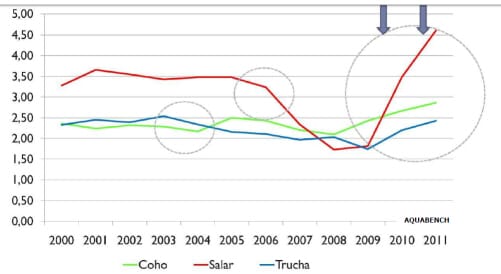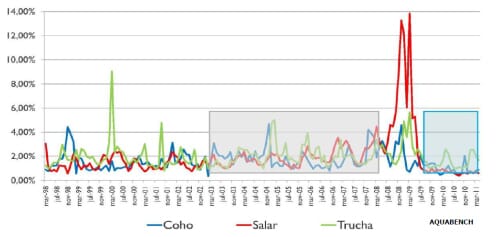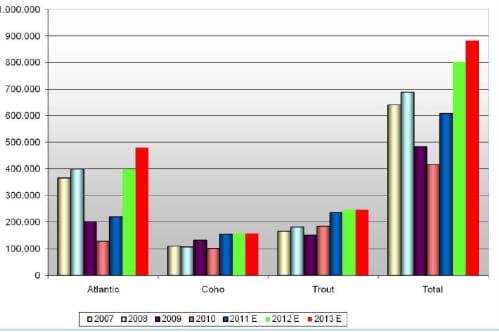Over the last 25 years, aquaculture production in Chile has grown steadily. However it was around 2000, when production started to shoot up.
Maximum harvested biomass was reached in 2006, at over 600,000 tonnes.
"Although more and more eggs were transported to sea, good growth rates were not achieved, and the quality of fish was poor," said Mr Dempster.
"In 2007, the outbreak of infectious salmon anaemia (ISA) put salmon production back 10 years. In 2010, biomass production was equivalent to what it was in 2000 (before the aquaculture boom)."
Atlantic salmon was the most affected species in terms of biomass production.

Yields
Between 2000 - 2006, yields for Atlantic salmon averaged 3.5 kg per smolt. After the crisis, these yields dropped to below 2kg. However, Mr Dempster points out that yields actually began to drop as early as 2005.
For trout, peak yields were reached as early as 2003. This drop in yields, suggests that something else was wrong in the industry, before ISA hit, said Mr Dempster.
Now the industry is beginning to recover, yields have increased significantly, hitting an all time high of 4.5 kg per smolt for Atlantic salmon. Trout yields are back at 2003 levels (2.5 kg per smolt), whilst Coho salmon levels are nearly reaching 3 kg per smolt, nearly 0.5 kg more than before the crisis.
"So for Atlantic and Coho salmon, we are seeing the highest ever performance levels," he said.
Mr Dempster describes the rapid increase in yields and harvest weight as a mystery. "Never before have we grown fish as fast as we can now."
Mortality
Between March 2008-2009, there was a 14 per cent increase in mortality rates for Atlantic salmon. Before this mortality rates had been around two per cent. Now after the crisis, mortality rates are below one per cent.
Lice
As of 2006, the number of lice (caligus) per fish shot up, peaking in the summer of 2007 at over 30 lice per fish. Mr Dempster said that with parasite pressure peaking in 2007, it is believed to have played a key role on the ISA outbreak.
Since the ISA outbreak, parasite pressure is well below pre-crisis levels.

The Future
During the crisis, egg demand nearly halved.
Since the outbreak of ISA, strict controls have been put in place to reduce the risk of importing disease into the country.
Egg importation rules state that only Denmark, Iceland and Australia are allowed to export eggs into Chile. This fall in egg imports, means that more eggs will need to be produced in Chile.
However efficiency has increased, in 2006 it took five eggs or more to produce one smolt. This has reduced to 1.6 eggs per smolt.
Mr Dempster said that whilst this was excellent news, greater investment is needed in Chile if the country wants to increase production.
Nearly all Atlantic salmon smolts are produced in land based hatcheries, which means that investment is needed in new land based hatcheries to reach production targets.
Hatcheries are desperately required as the country becomes more dependent on its own egg production.
Farm Sizes and Risks
Since the ISA crisis, salmon farming is much more regulated. There are timing restrictions on smolt transfer from freshwater, fish movements between sea water farms are forbidden, and areas are split into neighbourhoods, where strict fallow periods must be followed.
Triggered by economies of scale and decreased availability of farms, the number of smolts per farm is increasing. In 2006 the average production was over one million smolts per farm. During the crisis the number of smolts produced on each farm fell by 200,000 smolts per farm, production is increasing, with the average now being 800,000 smolts per farm.
With the new regulations, Mr Dempster questioned whether there might be rules brought in to limit the amount of fish which can be produced on an individual farm.
Increasing Biomass
Standing biomass is increasing from its record low in December 2009. During 2009 there were almost no Atlantic salmon in the water, and the levels of standing biomass undoubtedly played a huge role in the recovery of the industry.
Standing biomass in 2011 is growing fast but still at about 63 per cent below its peak in 2008.

The production of Atlantic salmon is expected to increase over the next few years. Harvested biomass in 2009 and 2010 reached its lowest in the last 10 years. However since then production has been steadily increasing.
Growth is expected to peak in 2013 at 900,000 tonnes.
Mr Dempster said that 76 per cent of the industry's growth will be based on Atlantic salmon.
Future Challenges
Structural: How can Chile make rational and sustainable use of a common resource? Is this at all possible, asked Mr Dempster.
Since the crisis, there are more management methods which have been introduced to control disease risks. Each neighbourhood must enter a fallow period at designated times. There are heavy fines for those not complying.
The difficulties occur when companies own a different number of farms/ licences in various neighbourhoods. This makes the situation increasingly difficult to control.
The Chilean industry is the only aquaculture industry that is deconsolidating, said Mr Dempster. Prior to the crisis, 18 companies were responsible for 80 per cent of overall production. Now there are more players in the industry, with five to six companies explain 50 per cent of the growth, and 25 companies covering the remaining 50 per cent.
Mr Dempster said that with more people involved in the industry and such a fragmented structure, it becomes more difficult for decisions to be reached.
Economic performance in the last four years has shifted from record lows to record highs. All companies operating in Chile are reporting positive EBITDA over the last 18 months, said Mr Dempster.
IPOs and good operational performance has allowed most companies to escape from bankruptcy and prepare them for future growth.
These strong results over the last two years are down to the above average prices received over the last two years.
However, Mr Dempster said that the new regulations coming into play are bound to increase the cost of production, and it won't be long until companies see this impacting business.
Prices have now, unfortunately, dropped, said Mr Dempster. This is a huge concern to the Chilean industry. Only the best farmers are able to make money on these prices. The price drop was unexpected, as although supply is increasing, this has not yet been recognised by the market place. Mr Dempster said that there are other external factors affecting salmon prices.
Conclusion
Mr Dempster said that surprisingly, the performance across the whole industry was exceedingly good today, much better than it had been before the crisis, with the industry showing strong recovery.
More research is needed to determine the grounds for this amazingly fast biological recovery. It is likely that standing biomass and biomass density is one of the most relevant causative factors.
Mr Dempster recommended the establishment of limits for existing licences, to avoid another very expensive crisis, that could result from Chile producing fish at much higher densities than the rest of the world.
The new regulations put in place have meant more investment is needed - not in growing fish, but in breeding future generations.
Whilst many predict growth in production, the price drop is very worrying, and could easily prohibit the industry's growth, Mr Dempster concluded. September 2011




